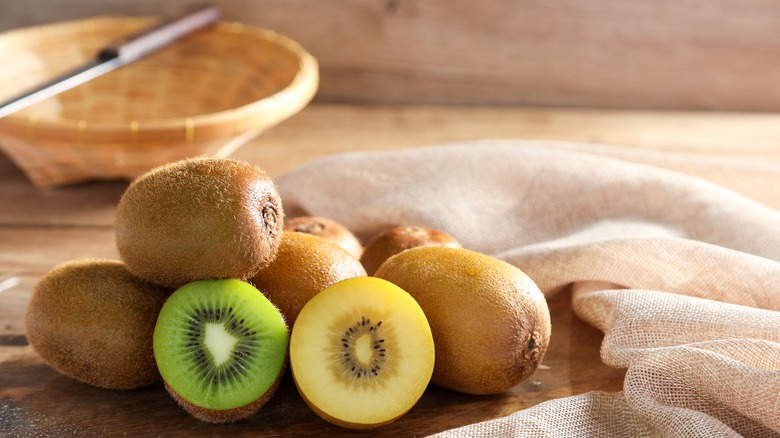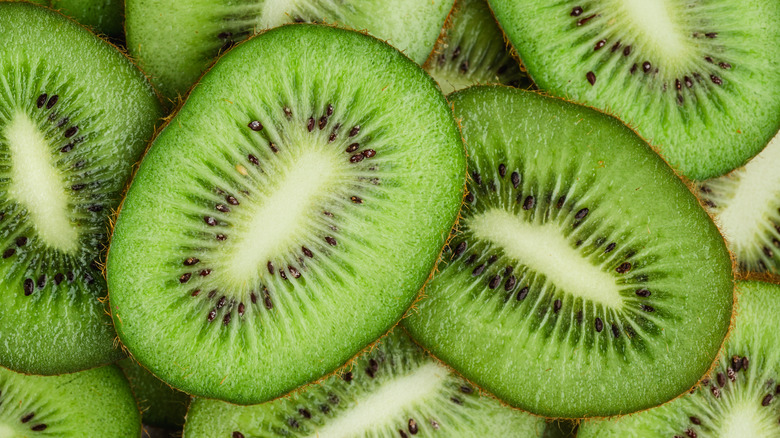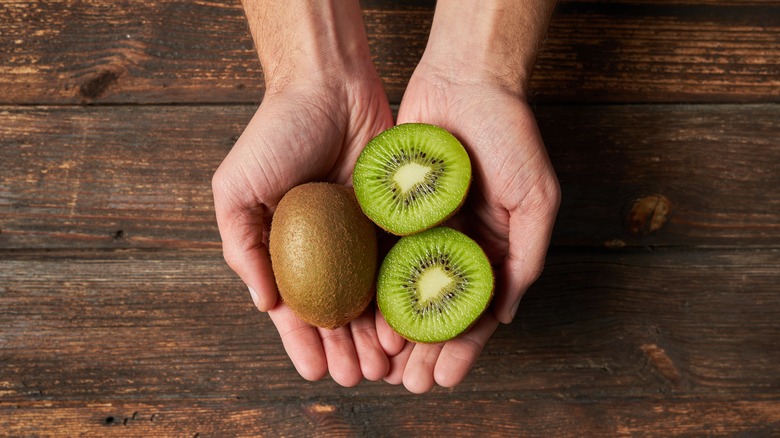Can You Really Eat Kiwi Skins?
If you were handed a hairy kiwi, would you peel it first, or bite right into it? Some have been doing the latter lately — from healthfluencers to Wednesday Addams herself, Jenna Ortega. When Ortega posted an Instagram story showing her biting into a whole kiwi, people had thoughts. "Jenna Ortega eats kiwis like a psychopath," noted @awoominjiyoo on Twitter. On a similar TikTok, some commenters touted kiwi skins as a constipation remedy, while user, @emilees.bookshelf, remarked "Your mouth will be so itchy though ... the trade-off is steep." Everyone has a point here. You can eat kiwi skins and they do have benefits, but they're not for everyone.
Traditionally, the fuzzy brown skin of kiwifruit is peeled away to reveal its tangy, vibrant (usually green or yellow) flesh. There are over 60 varieties of this hairy little fruit, which was native to parts of Russia and China before making its way to New Zealand, where over 90% of the world's kiwi comes from today. Around the world, there are a variety of ways to enjoy kiwi, from skin-on to sliced fruit salad.
While the thought of eating kiwi skin might make your skin crawl at first, think of all of the fruits and vegetables we eat with their skins, from peaches to watermelon rinds (yep, they're edible), these plant parts have a lot to offer. Some notable exceptions include unappetizing banana peels (which can be repurposed) and potentially harmful green potato skins.
The benefits of whole kiwi
Kiwi skins are safe for most people to eat. The only exception is, because kiwi skin is high in oxalates, it can contribute to kidney stone formation in certain people. Otherwise, the skin has a lot going for it in the nutrition department. As it turns out, there is some truth to the claim that kiwi helps with digestion. Although most research has been done on skinless kiwifruit, one notable study published in the American Journal of Gastroenterology found that eating two kiwifruits daily was associated with reduced constipation and gastrointestinal discomfort.
For evidence on kiwi skin, look to the (hairless) SunGold variety. Research published in the European Journal of Nutrition showed that eating its skin comes with nutritional benefits, including 32% more vitamin E, 34% more folate, and 50% more fiber. For some added context, a serving of two skin-off golden kiwifruit has two grams of fiber, so a skin-on serving would have four grams. This puts a decent dent in the daily fiber target of 38 grams for men and 25 grams for women.
Aside from nutrition, the convenience factor of whole kiwifruit is also appealing. While scooping out the flesh or peeling it away certainly gets rid of unsightly hair, it's also quite tedious. Without this step, you can simply wash, crunch, and enjoy your kiwi in a snap.
How to eat kiwi skin (and like it)
If you're new to eating kiwi skin, you may want to start with a less hairy variety. Golden kiwis have smoother, less prickly exteriors and may be more appealing to the uninitiated. You can also opt for kiwi berries, which are tiny, tart, and meant to be eaten with their skin on.
Once you're brave enough to try a fuzzier, green kiwi, there are quite a few ways to do so. Start by giving the fruit a good scrub as you wash it, buffing away some of the hair. Then, you can either embrace the crunch and bite into it whole, or slice it into more manageable pieces. Blending your whole kiwi into a smoothie or putting slices in a dehydrator are also tasty options.
Whether green or gold, hairy or peeled, all kiwis are nutritious additions to your diet. The choice to try the skin (or not) should be based on what you'll actually eat. After all, the nutritional value of a food you won't eat is zero. So if eating kiwi skins still sounds like a no-go, that's okay. But if you're inclined to try, you can munch away knowing their skins are both safe and good for you.


